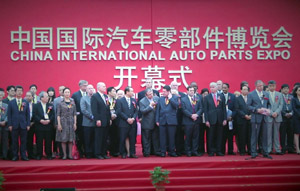Why economic slowdown can mean good news
Updated: 2013-09-20 15:32
By Mark Williams (China Daily)
|
|||||||||||
Slower growth, weaker investments are essential tools for achieving sustainability goals
Evidence of an economic revival over the summer has settled the nerves of the many China watchers who had been worrying about an imminent crash. Those earlier fears were probably exaggerated, but the relief with which the upturn has been greeted is misplaced too. A further slowdown would be in China's economic interests.
There is no great mystery about the recent economic turnaround. Indeed, it would have been a surprise if it hadn't happened. In each of the first eight months of this year, the total value of outstanding credit in the economy was a fifth or more greater than in the same month a year before. This flow of new credit is now fuelling stronger spending.
The credit boom is not on the same scale as that in 2009, but the turnaround in the economy is in some ways remarkably similar. The big increase in spending has been in infrastructure-related investment by state-owned enterprises. This in turn has triggered a surge in output from heavy industry. There is little sign that the revival is spreading to the rest of the economy. Private sector investment has not picked up. Household spending growth appears stable.
If headline GDP growth were all we cared about, the pattern of growth wouldn't matter. But in China's imbalanced economy, another credit-fueled and investment-driven turnaround is no cause for celebration. China's capital stock is already larger relative to the size of the workforce than the capital stock of Mexico, Brazil or Russia, even though output per employee is much lower in China than in any of these three nations. The legacy of years of imbalanced growth is that investment accounts for close to half of all spending.
There are three reasons why such a high investment rate can be a problem. The first is that it can increase the vulnerability of the economy to shocks. In general, firms are more likely to cut back on investment when conditions worsen than households are to reduce their spending, so high investment economies are at risk of more volatile growth. In China, the ability of the state to direct SOEs to spend when the economy slows means this problem is less severe than elsewhere. But greater short-term stability is achieved only by magnifying other risks.
For example - and this is the second reason that rapid investment growth can be a problem - China's dependence on investment in good times and bad is undermining the stability of its financial system by generating an unsustainable expansion of credit. A recent study by the IMF concluded that an increase in credit to GDP of more than 3 percentage points a year could serve as an early warning signal of financial stress. In China, credit has risen from 130 percent to 200 percent of GDP in just five years.
The third reason a high investment rate is a concern is that it raises the chances that investment is misallocated and that resources are wasted.
Rapid investment in a sector will tend to squeeze the profits of even the best-run firms. The good news, and the main reason that earlier fears of an imminent landing in China were misplaced, is that Chinese firms in general still appear to be generating decent profits, which suggests that the over-investment problem is still manageable, at least for now. Conditions have improved considerably since 2009, when profit margins shrank in the wake of the global financial crisis.
Yet it is not hard to find signs of stress in individual sectors. In the steel industry, for example, nearly half of domestic producers were running at a loss in the first half of the year. The auto sector is also struggling. Capacity has increased far faster than sales, forcing dealers to cut prices in order to offload inventories.
Meanwhile, the sector where oversupply threatens to have the largest macroeconomic impact is housing, which directly accounts for 9 percent of China's economic output. If real estate investment continues at its recent rate, housing completions will double by the end of the decade, leading to massive oversupply.
For these reasons, the ongoing investment-driven rebound is a concern. The longer it continues, the greater the threat that overcapacity will spread to other sectors of the economy. Indeed, given that the earlier economic slowdown was not sufficient to pull down investment's share of spending, the route to a sustainable growth path requires not just that the ongoing economic rebound stalls, but that it reverses and that growth then continues to slow on the back of weaker investment. Such a course of events would undoubtedly reawaken fears of a hard landing. In fact though, it is the route China needs to take to achieve healthier growth over the years ahead.
The author is chief China economist at Capital Economics, a London-based macroeconomic consultancy.
(China Daily European Weekly 09/20/2013 page9)
Today's Top News
Verdict of Bo Xilai: Life in prison
Russian embassy to Syria shelled
Gunmen holding hostages in Nairobi
Amber alert across Asia, but not red
China signs 12 deals with Venezuela
Bo Xilai gets life in prison
New Sino-US ties sought
One Chinese killed in Nairobi attack
Hot Topics
Lunar probe , China growth forecasts, Emission rules get tougher, China seen through 'colored lens', International board,
Editor's Picks

|

|

|

|

|

|





